#academic corruption
Explore tagged Tumblr posts
Text
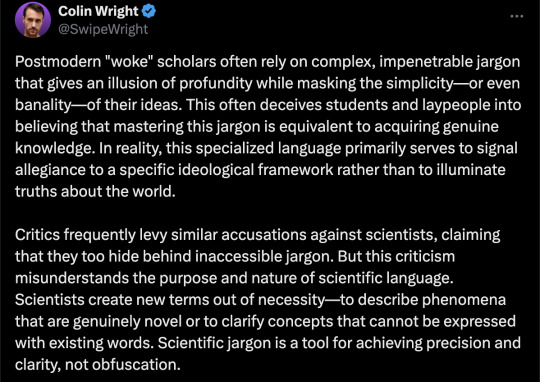
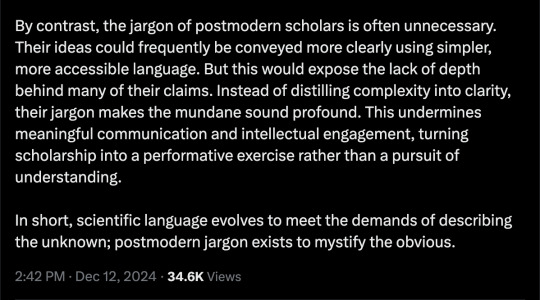
youtube
https://www.merriam-webster.com/dictionary/specious
1 : having a false look of truth or genuineness : sophistic specious reasoning 2 : having deceptive attraction or allure 3 obsolete : showy
--
Noam Chomsky: If you look at what's happening, I think it's pretty easy to figure out what's going on. I mean, suppose you are a literary scholar at some elite university. Or, you know, anthropologist or whatever. I mean, if you do your work seriously, that’s fine, you know. But you don’t get any big prizes for it.
On the other hand, you take a look over in the rest of the university and you’ve got these guys in the physics department and the math department and they have all kinds of complicated theories, which of course we can’t understand, but they seem to understand them. And they have, you know, principles and they deduce complicated things from the principles and they do experiments and they find either they work or they don’t work. And that’s really, you know, impressive stuff.
So I want to be like that too. I want to have a theory. In the humanities, you know, literary criticism, anthropology and so on, there’s a field called theory. We’re just like the physicists. They talk incomprehensibly, we can talk incomprehensibly. They have big words, we’ll have big words. They draw, you know, far-reaching conclusions, we’ll draw far-reaching conclusions. We’re just as prestigious as they are.
Now if they say, well look, we’re doing real science and you guys aren’t, that’s white male, sexist, you know, bourgeois or whatever the answer is. How are we any different from them?




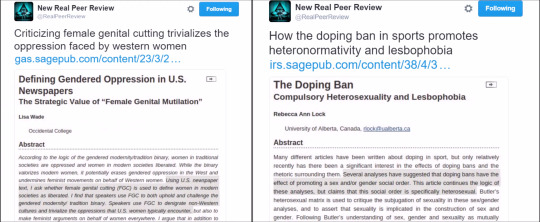
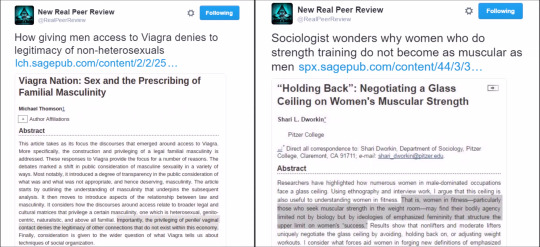
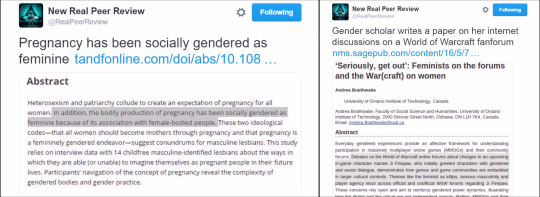
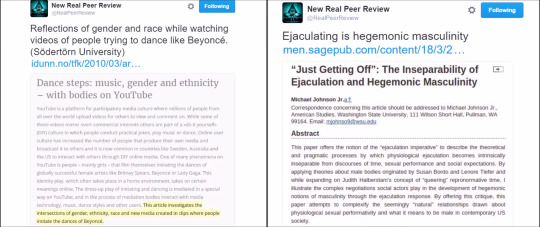
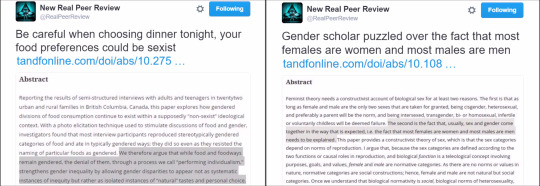
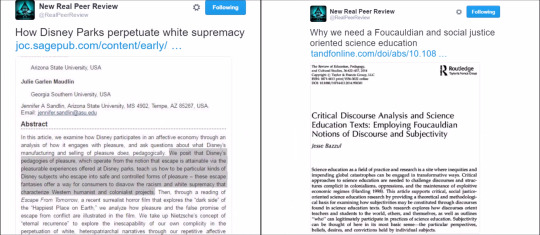


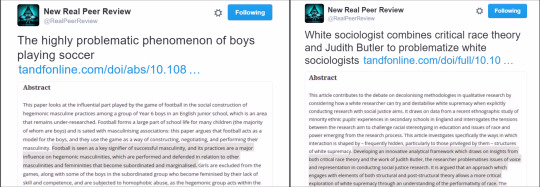
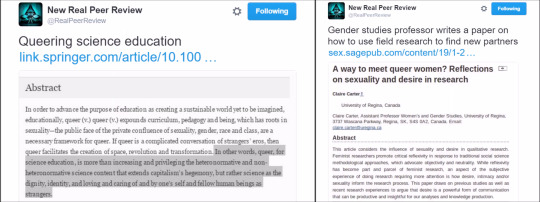

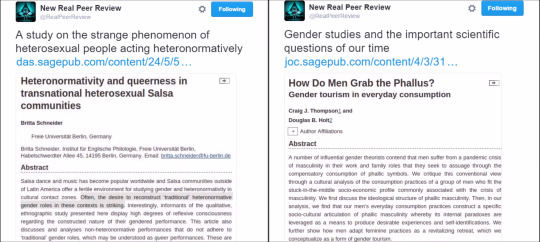
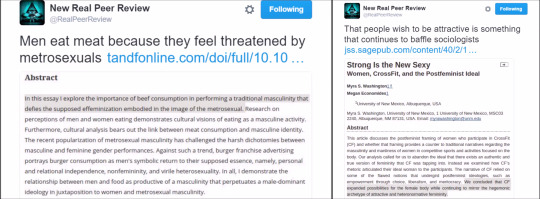
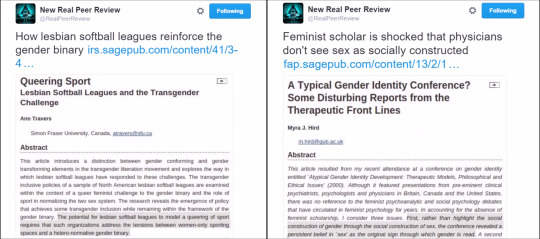
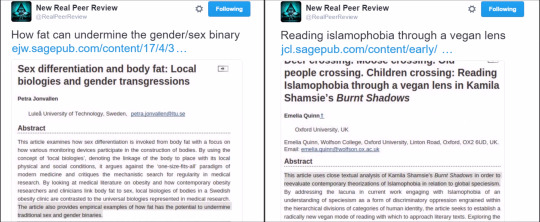
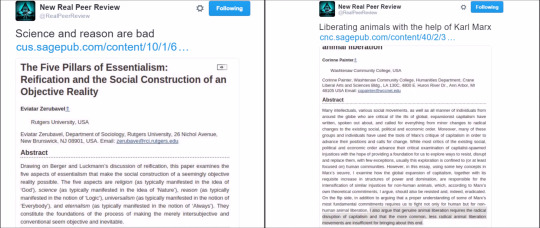
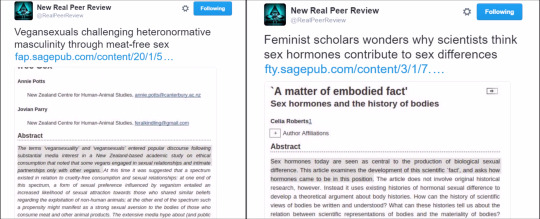
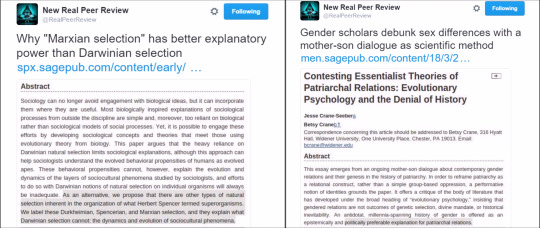

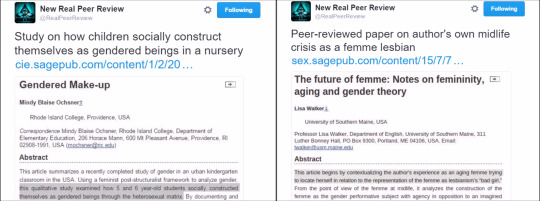
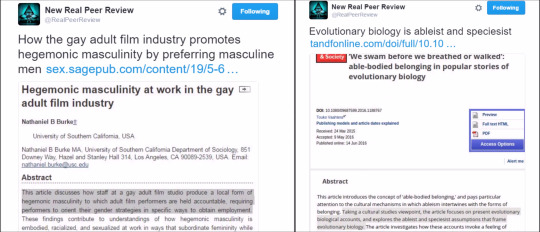
==
I worry that when I describe this idiocy as "fraud," people think I'm exaggerating, being hyperbolic or otherwise overstating it.
I'm not. If anything, I'm understating it.
All of this postmodern crap we're dealing with is completely fake. All this ridiculous intersectional jargon is a big grift. All of these domains producing this ridiculous nonsense are bogus and corrupt. All the scholarship they produce is fraudulent. It's fake from top to bottom.
All of it.
These people are cloaking asinine retardation in fancy words to cover up how asinine and retarded this asinine retardation is.
The people producing it are shallow and stupid. Not to mention, envious and spiteful about the status and authority of science. They just use absurd jargon to hide that fact and trick you into thinking it's too deep and profound for you to understand. But when it's decoded into simple English, à la the Tweet summaries above, the retarded, moronic nature becomes obvious.
The response to this kind of ridiculous shit needs to be laughter and derision, not tenure or a tertiary qualification.
We have to get rid of it because it's destroying our societies.
#Colin Wright#postmodernism#woke doctrine#feminism#feminist theory#woke nonsense#social constructivism#academic fraud#defund gender studies#gender studies#academic corruption#critical theory#critical race theory#intersectionality#intersectional feminism#patriarchy theory#patriarchy#science#what science is#religion is a mental illness
68 notes
·
View notes
Text
Plague of Plagiarism - The Cruel Case of Claudine Gay
youtube
1 note
·
View note
Text

But where have we come? And where shall we end?
#can you tell I was listening to the Over the Garden Wall soundtrack#lowkey inspired by those pumpkin people I did ages ago#I need to draw so bad this (modern) design degree absolutely fried my creativity#also procreate stop corrupting my files challenge#like it has to be cos my iPad is so low on storage but I was trying to draw something for a friend#and it was like What Drawing#trying to also draw more Autumn and Winter stuff!#I’ll hopefully be selling them at irl fairs this academic year#my art#illustration#autumn#fall#fall aesthetic#halloween#halloween aesthetic#halloween art#fall art#spooky aesthetic#pumpkin
2K notes
·
View notes
Photo

5 notes
·
View notes
Text
psst. hey. are there any fics where ford is a priest or maybe a monk and bill is a demon that corrupts him
#priest is way hotter but monks did like. research and academics and shit so it fits him better I feel#I’m a queer that was raised catholic so blasphemy and corrupting the devout is so hot to me#don’t let me down Billford nation…..
3 notes
·
View notes
Text
Rereading the Roman portion, and I hate the word "salt" more and more. Chemically, it's shorthand for an oxidized metal cation attached to a soluble anion, but it just makes me think of table salt.
Can't really change it unless I reupload the citations reblog, so it'll have to stay, but in the future, start punching me if I use 'lead salt'.
#It's one of those academic terms that are just... stupid? I think if you're going to use academic jargon you need to come up with terms#that aren't commonly used; or the term is notably different due to context. Salt is commonly used and isn't notably different;#hence mass confusion when that academic -> casual transition is made.#ptxt#I'm supposed to be copy-pasting my data that got corrupted yesterday. My motivation... it's low....#Used all my spoons yesterday apparently. Or I need to start the day by reading? For some reason that worked great the last two days. idk
5 notes
·
View notes
Text
i get why people would opt to say walter was a terrible person since the beginning, but i think that's like, the most boring takeaway you can get about his character. he was already insecure and prideful from the start, and it's what would hurt him and keep hurting him. but like, being insecure and prideful are regular traits any regular person can have. the actions that he makes because of these traits, which in turn keep fueling his ego more and more, are what makes him an interesting character. and he was already pretty capable of hurting other people, but he wasn't doing it out of malice, but more because of careless selfishness at first. what makes walter terrifying is that the more he does it, the more he becomes aware of what he's doing, and the more he keeps going and keeps being more and more meticulous and deliberate about what he does that hurts people and even to the point when it was specifically to hurt people.
i think the traits were there in walter from the beginning—the pilot did a pretty good job of establishing how powerless he's felt all his life and just how susceptible he is to letting this newfound perceived power get to his head so easily. he even says this explicitly in 5x06 "Buyout" when he tells jesse "i'm not in the money business, i'm in the empire business". but saying he was this monster from the start kind of implies he didn't undergo through a character arc throughout the show when it's quite literally what he did. he got worse. so much worse. through mostly the fault of his own fragility.
#idk if i put it into words right but i'm just musing#was walter a good person when brba started? up in the air. but his family genuinely adored him. despite feeling like a loser teacher#some of his coworkers actually really liked and respected him. he was just as much of a regular person as anyone else was tbh#you know it's interesting that he and gale basically have the same motivations. why jump to meth of all things. why go from 0 to 100 when#it sounds COMPLETELY ridiculous. but they were both very passionate about chemistry who felt like their potentials were wasted and felt#like they were finally putting their skills to good use again. getting to flex their muscles and shit. whenever they cook better purer meth#than most other people. i think it's a really genius idea to have this premise for the show lol#cz as much as walter is motivated by him feeling like he desperately has to take control of his own life he also is a scientist at heart#who desperately needs to apply his knowledge and skills somewhere where it would feel gratifying#seriously dude you could've tried to get a paper published or two or something. djhdidhd#but the academe has its own Politics and whatnot. so one could only speculate why walt didn't get to pursue that any more#(aside from the whole grey matter industries thing)#anyway uhhh i hope i get the post across lol not to sound cheesy cliche but brba is a corruption slash character deterioration arc#quite literally the whole point is that he Didn't Start Off Like This And He Gets Worse#again. he already had some of his bad tendencies and traits but it's like. we all do that's not necessarily inherently make or break#it's what he DOES and KEEPS DOING. CONSCIOUSLY that turns him into the horrifying man he is by the end of it all#so i just think if your biggest takeaway is Walter Was Always A Monster then you're just missing the whole damn point#op#brbaposting
37 notes
·
View notes
Text
By: Elizabeth Weiss
Published; Jan 17, 2025
Biological anthropology and archaeology are facing a censorship crisis. Censorship can be defined simply as the suppression of speech, public communication, or information, often because it is deemed harmful or offensive. It can be enforced by government agencies or private institutions. Even self-censorship is increasingly prevalent, such as when an author decides not to publish something due to fear of backlash from their colleagues, or the belief that their findings may cause harm.
In these fields, censorship is primarily driven by professional associations like the American Anthropological Association (AAA) and the California Society for Archaeology, academic journals (often produced by these associations) such as Bioarchaeology International, universities, and museums, including the Smithsonian National Museum of Natural History. The focus of this censorship largely involves the suppression of images—including X-rays and CT-scans—of human remains and funerary objects, which are artifacts found in graves.
Biological anthropologists, such as bioarchaeologists (who study human remains from the archaeological record), have historically used photos and X-rays of skeletal remains and mummies to explore disease patterns of past peoples, teach new methods of age estimation and sex identification, and attract new students to the field of biological anthropology. Archaeologists use photos of artifacts to facilitate comparisons with other artifacts, aid in reconstructing past cultures, and explore topics like the peopling of the Americas, prehistoric trade patterns, and the emergence of new technologies. These are just a few of the many ways images have been used in the field.
Yet, in recent years, the use of photos of human remains and artifacts has faced increasing censorship. For example, the guidelines of the Society for American Archaeology (SAA) and its journals state: “Out of respect for diverse cultural traditions, photographs of full or explicit human remains are not accepted for publication in any SAA journal.”
Additionally, they add that “line drawings or other renderings of human remains may be an acceptable substitute for photographs.” In other words, they also may not be acceptable! So, the photo on the left would definitely not be accepted in SAA journals, and the image on the right may or may not be accepted.

In conference bookrooms, books featuring covers with photos or realistic images of bones are now being rejected for display. Ironically, just ten years ago, my cover photo from Paleopathology in Perspective: Bone Health and Disease through Time was so popular that someone stole the poster from the SAA conference bookroom. Just three years later, however, the SAA wouldn’t allow my publisher to buy advertising space using the cover of my book Reading the Bones: Activity, Biology, and Culture. Now, even realistic images of human remains are shunned! Somehow, I doubt my latest book, On the Warpath: My Battles with Indians, Pretendians, and Woke Warriors, will make it into any anthropology or archaeology conference bookrooms either!

Southeastern Archaeology, the journal of the Southeastern Archaeological Conference, has implemented a policy that it “will no longer publish photographs of funerary objects/belongings.” This is an expansion of their previous policy against publishing photographs of human remains. They now add that “in lieu of photographs, authors may choose to include line drawings or other representations of funerary objects/belongings.” This decision was initially made without member input, leading go backlash against the decision. However, after a discussion and a vote, the censorship was upheld. Majority rule is no way to run a scientific organization—which should be done on adherence to the principles and methodologies of science!
Not to be outdone by the southeastern archaeologists, the Society for California Archaeology (SCA) declared that “NO depictions of the remains of any specific person, regardless of ancestry, are to be included in any presentations, including photographs, drawings, X-rays, 3-D models, etc.” So, forget displaying any historic figures such as the mummy of Lenin, the death mask of Ishi, or the skeletal remains of Joseph Merrick (also known as the Elephant Man, who taught many people that physical deformity does not equate to a lack of intelligence). This restriction even extends to individuals like Jeremy Bentham, a professor from London College, who explicitly requested his preserved body be displayed, illustrating the breadth of these new policies. All of these and many others are now strictly off limits!

While banning photos, the SCA does permit the use of “[d]iagrams of generic skeletons, bones, teeth, or other body tissues.” Additionally, at their conferences, “[a] caution symbol will be placed next to all presentations discussing human remains in the program and on signage outside the door of the session so that those who wish to avoid this subject matter can easily do so.” Is education truly about avoiding uncomfortable information and materials?
The AAA’s Commission on the Ethical Treatment of Human Remains has ruled that images and digital materials must be treated as parts of bodies—and, thus, not published in any public spaces, including on social media. They state:
The use of images and any other digital materials (e.g. maps or GIS) derived from human tissues or Ancestral remains should be considered as part of the respectful treatment of those whose actual remains are used. This treatment acknowledges that their use should be restricted to defined (and consented) purposes, and that such use should remain confined to a protected, nonpublic space (and should never be displayed on social media or other non-password protected internet sites, including educational sites, and museums).
In other words, even maps constructed with DNA information are now subject to restriction!
They also plan to require members to take an “ethics pledge” to join or renew their membership. This is to ensure that no one goes rogue and shows a human bone in a place where someone might actually see it.
Journals that once served as valuable resources for understanding bone pathology (or disease) are now discarding the most important tool of all—images. Bioarchaeology International now demands “explicit recent permission” from descendants for the use of photos or images of human remains, even if the image were taken before these requirements and had been previously published (often on multiple occasions). These are referred to as “legacy images.” The journal further states that “if no permissions are forthcoming, the manuscripts are not considered for review.” Bioarchaeology International is not alone in censoring the use of legacy images; nearly all peer-reviewed anthropology and archaeology journals now enforce a similar policy.
One exception is the American Association of Biological Anthropology, which publishes the prestigious American Journal of Biological Anthropology. This organization specifies that the requirement to obtain permission for images and data of human remains applies only to new data; “legacy data is not included.” One wonders how long these comparatively ‘courageous’ holdouts will last before caving in. Currently, they have a committee developing a policy on human remains.
The International Journal of Paleopathology specializes in case studies of rare pathologies, where photos are essential to conveying information. The editorial board acknowledges the usefulness of photos, but they also state that:
While careful description of pathological lesions is essential to research in paleopathology, authors are encouraged to consider whether photographs of human remains are critical to the presentation of the research. If not essential, out of respect for descendent communities, they should be replaced with drawings or included as supplementary material. Authors may wish to consult the editor regarding these issues.
Can a line drawing really do justice to the complex and intricate changes that occur on skeletons due to diseases like osteomyelitis (bone infections), osteoarthritis, cribra orbitalia (a sign of anemia), or the various forms of dental disease seen sometimes in a single individual?

Beyond this censorship, institutions are also toeing the ideological line to exclude images of human remains. In September 2023, Penn Museum decided that its inventory would not include such images. And, the renowned Mütter Museum of the College of Physicians of Philadelphia, which aims to educate the public about anatomical medicine and health, has removed all images of human remains from its online database. This includes the image of Carol Orzel, who had specifically wished that her body be displayed to educate others about fibrodysplasia ossificans progressive, the painful, debilitating, and fatal bone and cartilage disease she suffered from.
The Santa Barbara Museum of Natural History��issues a warning to anyone who might find human remains: “Never take photos of human remains in our region; that is culturally inappropriate here.” But Santa Barbara is a region that encompasses many cultures, including some Central Mexican communities who do not view photographing human remains as inappropriate, as they celebrate their ancestral past by displaying the dead. For example, Lisa Holtzover and Juan R. Argueta note in their 2017 article that in the central Mexican town of Xaltocan, indigenous residents support archaeological research and the exhibition of ancient human remains. Yet, North American academics often criticize their cultural preferences, even while they claim to be decolonizing the field. In their blind adherence to wokeism, academics’ patronizing “we know best” approach towards indigenous peoples who deviate from their narrative exemplifies a white savior complex. Ironically, those who claim to oppose racism in their quest for wokeism are themselves perpetuating it. What next? Should we give Egyptian mummies a Christian burial in the name of decolonization?
Universities, especially in California, have also imposed complete moratoria on the use of human remains images. For example, on August 30, 2023, California State University Bakersfield’s president issued a moratorium that stated:
[T]he university is placing a moratorium on the research, teaching, display, imaging, and circulation of human remains and cultural items (including archival material, notes, movies, and data) that are potentially subject to NAGPRA and CalNAGPRA.
Similarly, on March 26, 2024, the president of California Polytechnic Pomona issued a memorandum stating:
Cal Poly Pomona will consult with Tribes prior to access, use, distribution or display of potentially sensitive or proprietary information. This includes but is not limited to images, renderings, and reproductions of ancestral remains and cultural items that are or have been in a university’s collection.
The universities are dressing up their actions as compliance with national and state reburial laws, yet these laws do not yet ban the use of images. And, from the look of anthropologists’ self-censoriousness and the acts of university presidents, new laws are likely not even necessary to restrict scientific research and educational efforts.
But this isn’t just a US problem. For instance, Uppsala University in Sweden advises that “photographs of human remains from indigenous ethnic groups are not normally to be published.” Similarly, the National Museum of Scotland has put out a statement that “All images of human remains except those that are wrapped have been removed from our online collections database.” At the Smithsonian National Museum of Natural History, this policy resulted in the absurd covering up of a mummy that was wrapped because of the photo behind the mummy contained images of skulls from a forensic collection.

One may wonder what has led to such vast censorship. Progressive anthropologists have decided that images—and, in some cases, data—from human remains and funerary objects cause harm to indigenous peoples. They adopt the narrative from indigenous activists that these images are dangerous, rather than explaining the importance of research and dispelling the notion that societal ills like alcoholism, missing women and children, and poverty stem from evil spirits roaming the earth and wreaking havoc on their lives.
For instance, in a 2020 book chapter on digitizing anthropological collections, Laure Spake and colleagues, citing the Smithsonian’s collaboration with the Tlingit, stated, “the disturbance of Ancestors and their belongings can result in physical danger for the living.” Ironically, the authors used this argument to advocate for 3D scanning and creating replicas to allow for the rapid reburial of human remains as quickly as possible—a viewpoint that is now considered outdated!
At a Native American Graves Protection and Repatriation Act meeting on January 5, 2023, there was a discussion on the deletion of digital data. Even non-fungible tokens (NFTs) were discussed, although those discussing them didn’t even know what they were. During the meeting, Hawaiian Native activists argued that it’s possible to “entice the spirit of someone to inhabit” photos, digital data, and replicas, which they assert can be harmful. Consequently, the tribe opposes making scans and casts.
Larry Zimmerman and Margaret Conkey, in their 2024 article for the SAA Record, argue that control over photos and data should belong to Indigenous communities because it is “respectful” to believe their feelings of harm. In their words, “when someone tells you that what you are saying or doing hurts them and you truly respect them, you will make every effort you can to eliminate or at least to understand the cause of the hurt.”
Furthermore, in the 2024 AAA Ethical Commission on Human Remains, Sabrina Agarwal and her colleagues repeatedly imply that harm will come to descendent communities from research. The term “harm” actually was mentioned 44 times, including in the statement:
As an ethical approach to ethical solutions, the Commission chose to meet with representatives of those most affected by anthropological work with ancestral remains to learn their assessments of how they might be harmed or protected from harm when research and education is considered.
In a 2020 article in Sapiens, Chip Colwell wrote that “photographs of human are problematic because of specific cultural beliefs.” He elaborates that the Navajo, for instance, believe encountering spirits of the dead can sicken those who see them. He helpfully then adds that photos are more harmful than line drawings, 3D scans, or casts.
Also in 2020, Deborah Thomas, then the editor-in-chief of American Anthropologist, selected a photo of Margaret Mead with skulls for an issue featuring a special section on the anthropology of global white supremacy, complete with a republished conversation between Mead and James Baldwin. The image sparked a social media uproar and was said to be violent, racist, and harmful to indigenous and black communities. Thomas, agreeing that the image produced trauma, changed the cover and issued a groveling apology, which included the statement that “We know the role that anthropology has played in the erasure of Indigenous peoples in the Americas through its salvage/savage ethnography project and its continued use of human remains for ‘research’ purposes.”
Unfortunately, by leaving anthropology and archaeology devoid of images of human remains and funerary objects, we will learn less about the past. Legacy data will not be allowed for comparative research, and our next generation of forensic anthropologists will be poorly trained. More troubling is that non-scientists who attribute normal human variation to supernatural or alien influences will continue to captivate young minds with sensational images, drawing them towards pseudoscience instead of a genuine scientific understanding of the world.
Moreover, we should not expect censorship in anthropology and archaeology will be limited to new publications featuring human remains. I have no doubt that woke academics and publishers will start to remove previously-published materials. For example, the University of Florida Press deleted the images from my blog post, “Human Variation: More Than Skin Deep!”—which was intended to promote my book Reading the Bones—two years after its initial publication on their blog.
What is the solution for anthropologists? Woke anthropologists suggest a different mindset is needed. Zimmerman and Conkey argue that archaeologists will be required to abandon “cherished ideas like academic freedom” and “relinquishing complete control, ownership, or even stewardship of excavated materials” to continue working in the field. Additionally, the AAA Commission on the Ethical Treatment of Human Remains would also like to curtail our desire for academic freedom. They write, in a scolding tone, that “Academic freedom is not synonymous with ‘unrestricted access.’ Scholars, educators and museum curators must be responsible to descendants’ concerns for the dignified treatment of their dead.”
Once academic freedom is relinquished and the data—images and all—are in the hands of activist descendant communities, don’t expect new scientific discoveries. Instead, expect woke fairy tales arising out of victim narratives.
Censorship (and self-censorship) of images should not be seen as an isolated issue. It’s symptomatic of a wider pathology afflicting the field. Anthropology is dying. But when it’s finally dead, don’t expect to see a picture of the body!
--
About the Author
Professor Emeritus of Anthropology at San Jose State University and National Association of Scholars Board Member. Author of On the Warpath: My Battles with Indians, Pretendians, and Woke Warriors.
==
This is unabashed corruption.
Any organization or institution which implements policies like this must be stripped of all government (i.e. taxpayer) funding. You don't get to implement ideological dogma when the taxpayer is paying for it.
#Elizabeth Weiss#anthropology#archaeology#academic corruption#ideological corruption#woke dogma#wokeness#cult of woke#wokeism#wokeness as religion#woke#academic freedom#corruption#religion is a mental illness
31 notes
·
View notes
Text


< books with playlists 3
#just finished Corrupt today so wish me luck with Hideaway!#aesthetic#dark academic aesthetic#bookblr#booklr#read books#book aesthetic#book blog#books & libraries#books#romance books#bookaddict#photography#dark acamedia#dark aesthetic#dark romance
14 notes
·
View notes
Text
youtube
For note: this isn't just a video about Atlantis, but a valid criticism of academic biases.
#video#the lore lodge#archeology#academia#academic corruption#academic bias#Graham Hancock#anthropology#Youtube
1 note
·
View note
Text
@scrivellc / plotted starter

"I miss you," she heard her own voice come softer, calmer than she'd thought it would. The lie didn't even hurt. But her band-aid wrapped finger twisted nervously in the phone cord as she looked out the shop window to the quickly emptying streets, betraying a certain fear.
Audrey was resolved — had been convinced — that tonight was the night to act, but she was suppressing a bone-deep terror at the thought of what had to be done. She hoped she'd have the stomach for it. She focused on the freshest bruise peeking out from beneath her sleeve, forcing herself to remember how his hand felt as it worked those purple marks into her skin. A lot of folks deserve to die.
"Everything's been so busy since the shop's taken off, and like I said, I been feelin' under the weather, but... I'm closin' alone tonight..." she trailed off meaningfully. "Come keep me company, doctor?"
Over her shoulder, the plant cackled a laugh that set its leaves rustling, and Audrey reached out with a hand and gently but firmly pushed its pod back and shush it.
#yeah orin <3 come to the little shop <3 there are no horrors in it i prommy <3#audrey corruption arc! audrey corruption arc! we love audrey corruption arc!#i emerge from the depths of academic hell to post this starter and then retreat to lurking lol#scrivellc#v; move heaven and hell
5 notes
·
View notes
Text
i know my friends are losing it over ianthe in "the unwanted guest" but may i just say as a palamedes bitch forever and always, YUM.
#locked tomb blogging#the unwanted guest#devotion as consumption#devotion as corruption and/or change#i'm such an academic#this and sophie's fic are making me realize how much of a nerd ianthe is#pero like pal is Old Skool nerd and i'm weak for it
10 notes
·
View notes
Photo

6 notes
·
View notes
Text
gomes asserts that by the time of the prohibitions of língua geral (first attempted in 1727, then finalized in 1757) língua geral had undergone such enormous change (via substratum interference, moore) from the language the jesuits wrote their catechisms in that it had already (in less than two hundred years) become dialectical into:
"língua geral verdadeira" (the jesuit's "real língua geral", more akin to the original tupinambá)
"língua geral corrupta" (the quotidian "corrupt língua geral")
this is incredible. the chaotic violence is palpable: all these various peoples of various linguistic backgrounds (some from the same language family, many not) shoved together in aldeias and "towns", most of them not fluent in língua geral yet being forced by proximity and the requirements of life into using língua geral and teaching it to their children who then grow up with these already-altered-still-being-altered forms, until in less than two hundred years the language has become demonstrably, identifiably divided from itself
this is substratum interference, btw (as opposed to borrowing)

#língua geral#historical linguistics#been a while since i could use that tag#adventures in post-academic academia#the “corrupt” is the one that survived btw#and went on to continue to change#and is still#today#spoken in amazônia
2 notes
·
View notes
Text
"He Always Talks About the West"-Former University President Sentenced to 11 Years in Prison in China
A former member of the Chinese Communist Party (CCP) and president of a prestigious university was sentenced to prison on charges of corruption and bribery. But among the reasons for his downfall are also his interest in the West and his alleged disregard for party discipline. An article in the latest issue of “China Discipline Inspection and Supervision Magazine” (中国纪检监杂志) reported that Li…
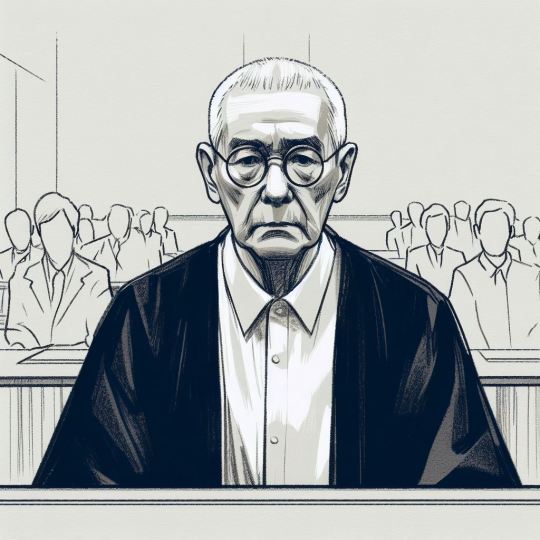
View On WordPress
2 notes
·
View notes
Text
The number of former politicians, journalists and bureaucrats, lacking a PhD or academic experience, being made "professors" in Australia is shocking and devalues the foundations of the academic system itself. Suitably called out by Public Universities AU:
#australia#ausgov#politas#auspol#tasgov#taspol#qualifications#academic#professors#devalued#morals#ethics#neoliberal capitalism#fuck neoliberals#anthony albanese#albanese government#corruption#corrupt politicians#corrupt police#education#university#school#political#politics#politician#class war#classwar#capitalism#anti capitalist#capitalist hell
2 notes
·
View notes